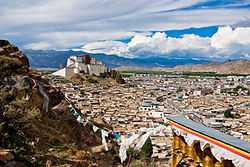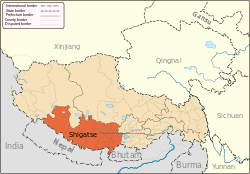Samzhubzê District
| Samzhubzê 桑珠孜区 · བསམ་འགྲུབ་རྩེ་ཆུས། | |
|---|---|
| District | |
|
Samzhubzê in 2009 | |
 Samzhubzê Location in the Tibet Autonomous Region | |
| Coordinates: 29°16′N 88°53′E / 29.267°N 88.883°E | |
| Country | People's Republic of China |
| Region | Tibet |
| Prefecture-level city | Xigazê |
| Township-level divisions | 12 |
| Seat | Chengbei Subdistrict |
| Area[1] | |
| • Total | 3,654.18 km2 (1,410.89 sq mi) |
| Elevation | 3,836 m (12,585 ft) |
| Population (2013)[2] | |
| • Total | 117,000 |
| • Density | 32/km2 (83/sq mi) |
| Time zone | CST (UTC+8) |
| Postal code | 857000 |
| Area code(s) | 0892 |
| Samzhubzê District | |||||||
| Hanyu Pinyin | Sāngzhūzī | ||||||
|---|---|---|---|---|---|---|---|
| Postal Map | Samdruptse | ||||||
| |||||||
| Tibetan name | |||||||
| Tibetan | བསམ་འགྲུབ་རྩེ | ||||||
| |||||||
Samzhubzê District (also spelled Sangzhuzi District, Samdruptse District) is a district in the Tibet Autonomous Region of the People's Republic of China, and the administrative center of the prefecture-level city of Shigatse (Tibetan Pinyin: Xigazê). Prior to 2014 it was known as Shigatse. It was the ancient capital of Ü-Tsang province and is the second largest city in Tibet with an estimated population of 117,000 in 2013. Samzhubzê is located at the confluence of the Yarlung Tsangpo River and the Nyang River (Nyang Chu or Nyanchue), about 250 km (160 mi) southwest of Lhasa and 90 km (56 mi) northwest of Gyantse, at an altitude of 3,840 metres (12,600 ft).
History
In the 19th century, the "Tashi" or Panchen Lama had temporal power over Tashilhunpo Monastery and three small districts, though not over the town of Shigatse itself, which was administered by two Dzongpön (Prefects) appointed from Lhasa.[3] Before military conflict between the PRC's People's Liberation Army and the then Tibetan Govt., the Tibetan territory was divided into 53 prefecture districts called Dzongs.[4]
There were two Dzongpöns for every Dzong—a lama (Tse-dung) and a layman. They were entrusted with both civil and military powers and are equal in all respects, though subordinate to the generals and the Chinese Amban in military matters.[5] However, there were only one or two Ambans representing the Qing (Manchu) Chinese emperor residing in Lhasa, directing a little garrison, and their power installed since 1728, progressively declined to end-up as observer at the eve of their expulsion in 1912 by the 13th Dalai Lama.[4] In 1952, shortly after the PRC sent forces to the region, Shigatse had a population of perhaps 12,000 people, making it the second largest town in Tibet.[6]
In 1959, Shigatse was made the administrative center of an eponymous special district (专区) of Tibet. In 1970 the special district was upgraded to a prefecture and the town designated a county. In 1986 the county became a county-level city, and when the prefecture was again upgraded to a prefecture-level city in 2014, the county-level city was redesignated a district and given the new name of Samzhubzê.[7]
Geography and climate
Samzhubzê lies on flat terrain surrounded by high mountains, and the urban area is located just south of the Yarlung Zangbo River. The city lies at an elevation of around 3,840 metres (12,600 ft), and within its administrative area there are five peaks higher than 5,500 metres (18,000 ft).[8] The city's administrative area ranges in latitude from 29° 07' to 29° 09' N and in longitude from 88° 03' to 89° 08' E.
Samzhubzê has a monsoon-influenced, alpine version of a humid continental climate (Köppen Dwb), with frosty, very dry winters and warm, wet summers. Temperatures are relatively moderate for the Tibetan Plateau, as the annual mean temperature is 6.48 °C (43.7 °F).[1] Barely any precipitation falls from November to March, when the diurnal temperature variation can frequently exceed 20 °C (36 °F). Nearly two-thirds of the annual rainfall occurs in July and August alone. Sunshine is abundant year-round, totaling 3248 hours annually.[8]
| Climate data for Samzhubzê (1971–2000) | |||||||||||||
|---|---|---|---|---|---|---|---|---|---|---|---|---|---|
| Month | Jan | Feb | Mar | Apr | May | Jun | Jul | Aug | Sep | Oct | Nov | Dec | Year |
| Record high °C (°F) | 18.6 (65.5) |
18.8 (65.8) |
22.9 (73.2) |
23.9 (75) |
28.5 (83.3) |
28.2 (82.8) |
28.2 (82.8) |
26.2 (79.2) |
24.4 (75.9) |
22.2 (72) |
21.1 (70) |
17.3 (63.1) |
28.5 (83.3) |
| Average high °C (°F) | 6.2 (43.2) |
8.3 (46.9) |
11.9 (53.4) |
15.5 (59.9) |
19.5 (67.1) |
22.3 (72.1) |
21.3 (70.3) |
20.2 (68.4) |
19.1 (66.4) |
16.1 (61) |
11.0 (51.8) |
7.2 (45) |
14.9 (58.8) |
| Daily mean °C (°F) | −3.2 (26.2) |
−0.1 (31.8) |
3.9 (39) |
7.6 (45.7) |
11.3 (52.3) |
14.5 (58.1) |
14.2 (57.6) |
13.3 (55.9) |
11.7 (53.1) |
6.9 (44.4) |
0.7 (33.3) |
−3.1 (26.4) |
6.5 (43.7) |
| Average low °C (°F) | −12.6 (9.3) |
−9.3 (15.3) |
−4.7 (23.5) |
−0.5 (31.1) |
3.5 (38.3) |
7.6 (45.7) |
8.8 (47.8) |
8.2 (46.8) |
5.8 (42.4) |
−1.2 (29.8) |
−8.3 (17.1) |
−12.1 (10.2) |
−1.2 (29.8) |
| Record low °C (°F) | −21.3 (−6.3) |
−19.4 (−2.9) |
−14.4 (6.1) |
−9.5 (14.9) |
−4.9 (23.2) |
0.6 (33.1) |
2.2 (36) |
0.5 (32.9) |
−1.6 (29.1) |
−9.8 (14.4) |
−15.5 (4.1) |
−18.6 (−1.5) |
−21.3 (−6.3) |
| Average precipitation mm (inches) | .4 (0.016) |
.2 (0.008) |
.6 (0.024) |
2.1 (0.083) |
18.7 (0.736) |
64.0 (2.52) |
129.6 (5.102) |
152.3 (5.996) |
56.2 (2.213) |
5.4 (0.213) |
.9 (0.035) |
0 (0) |
430.4 (16.946) |
| Avg. precipitation days (≥ 0.1 mm) | .2 | .5 | .7 | 2.2 | 6.4 | 12.4 | 18.8 | 20.8 | 13.0 | 2.2 | .4 | .1 | 77.7 |
| Source: Weather China | |||||||||||||
Administrative divisions
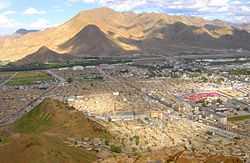
Shigatse administers two subdistricts and ten townships.[1]
| # | Name | Hanzi | Hanyu Pinyin | Tibetan | Wylie | Population (2010)[9] | Area (km²) |
|---|---|---|---|---|---|---|---|
| 1 | Chengbei Subdistrict | 城北街道 | Chéngběi Jiēdào | ? | ? | 13,110 | 70 |
| 2 | Chengnan Subdistrict | 城南街道 | Chéngnán Jiēdào | ? | ? | 50,857 | 90 |
| 3 | Lhain Township | 联乡 | Lián Xiāng | ? | ? | 4,823 | 514 |
| 4 | Nyamo Township | 年木乡 | Niánmù Xiāng | ? | ? | 3,347 | 330 |
| 5 | Jangdam Township | 江当乡 | Jiāngdāng Xiāng | ? | ? | 4,951 | 304 |
| 6 | Benxung Township | 边雄乡 | Biānxióng Xiāng | ? | ? | 4,106 | 230 |
| 7 | Donggar Township | 东嘎乡 | Dōnggā Xiāng | ? | ? | 8,625 | 428 |
| 8 | Nyarixung Township | 聂日雄乡 | Nièrìxióng Xiāng | ? | ? | 5,119 | 555 |
| 9 | Gyacoxung Township | 甲措雄乡 | Jiǎcuòxióng Xiāng | ? | ? | 11,946 | 471 |
| 10 | Qugboxung Township | 曲布雄乡 | Qǔbùxióng Xiāng | ? | ? | 5,428 | 310 |
| 11 | Qumig Township | 曲美乡 | Qǔměi Xiāng | ? | ? | 5,998 | 356 |
| 12 | Nar Township | 纳尔乡 | Nà'ěr Xiāng | ? | ? | 2,064 | 207 |
Tashilhunpo

Samzhubzê contains the huge Tashilhunpo Monastery, founded in 1447 by Gendun Drup, the First Dalai Lama.[10] It is the traditional seat of the Panchen Lamas. Until the Chinese arrived in the 1950s, the "Tashi" or Panchen Lama had temporal power over three small districts, though not over Samzhubzê itself, which was administered by a dzongpön (general) appointed from Lhasa.[3] In the 2nd week of the 5th lunar month (around June/July), Tashilhunpo Monastery is the scene of a 3-day festival and a huge thangka is displayed.[11]
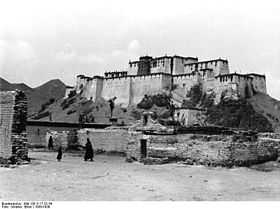
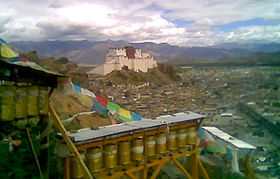
The imposing castle, Samdrubtse Dzong or "Shigatse Dzong", was probably built in the 15th century. It looked something like a smaller version of the Potala Palace in Lhasa, and had turret-like fortifications at the ends and a central Red Palace. It used to be the seat of the kings of Ü-Tsang and the capital of the province of Ü-Tsang or Tsang.[12]
The castle was totally dismantled, rock by rock, by hundreds of Tibetans at the instigation of the Chinese in 1961.[13][14] Between 2005 and 2007, the building was reconstructed, financed by donations from Shanghai. Old photographs served as a basis for the reconstruction, which was executed in concrete.[15] Afterwards, the exterior was to be wainscotted with natural stones. The dzong, which in the 17th century served as a model for the construction of the Potala Palace, is set to become a museum for Tibetan culture.
Nearby attractions include:
- Shalu Monastery
- Narthang, the first printing establishment in central Tibet
- Mount Everest
Infrastructure and transport
- Samzhubzê is the hub of the road network between Lhasa, Nepal and western Tibet.
- Construction started in 2010 of the Lhasa–Shigatse Railway to Samzhubzê and was completed in 2014. Start operated on 15 August 2014. A further extension to the Nepalese border is planned.[16]
- The nearest railhead in India is the station of New Jalpaiguri, a suburb of Siliguri, West Bengal.
- Shigatse Peace Airport began operations on 30 October 2010 and was Tibet's fifth commercial airport. It is located 43 kilometres from central Shigatse at Jiangdang village at an altitude of 3,782 metres. The airport is designed to handle up to 230,000 passengers annually by 2020.[17]
- China National Highway 318
Footnotes
- ↑ 1.0 1.1 1.2 日喀则市. Xzqh.org. Accessed 26 May 2011
- ↑ "西藏日喀则市桑珠孜区国家新型城镇化综合试点工作方案要点" [Summary report on the National New Comprehensive Urbanization Pilot Study in Samzhubzê District, Xigazê, Xizang] (in Chinese). askci Corporation (中商情报网). Retrieved 23 April 2015.
- ↑ 3.0 3.1 Chapman, Spencer F. (1940). Lhasa: The Holy City, p. 141. Readers Union Ltd., London.
- ↑ 4.0 4.1 Le Tibet, Marc Moniez, Christian Deweirdt, Monique Masse, Éditions de l'Adret, Paris, 1999, ISBN 2-907629-46-8
- ↑ Das, Sarat Chandra. (1902). Lhasa and Central Tibet. Reprint (1988): Mehra Offset Press, Delhi, p. 176.
- ↑ Richardson (1984), p. 7.
- ↑ Li, Zhe. "西藏日喀则成为中国最年轻地级市". http://news.china.com.cn/''. 中国网. Retrieved 13 July 2014.
- ↑ 8.0 8.1 日喀则市概况. Accessed 26 May 2011.
- ↑ shi, Guo wu yuan ren kou pu cha ban gong; council, Guo jia tong ji ju ren kou he jiu ye tong ji si bian = Tabulation on the 2010 population census of the people's republic of China by township / compiled by Population census office under the state; population, Department of; statistics, employment statistics national bureau of (2012). Zhongguo 2010 nian ren kou pu cha fen xiang, zhen, jie dao zi liao (Di 1 ban. ed.). Beijing Shi: Zhongguo tong ji chu ban she. ISBN 978-7-5037-6660-2.
- ↑ Chö Yang: The Voice of Tibetan Religion and Culture. (1991) Year of Tibet Edition, p.79. Gangchen Kyishong, Dharmasala, H.P., India.
- ↑ "Introducing Shigatse."
- ↑ Mayhew, Bradley and Kohn, Michael. (2005). Tibet, p. 172. 6th Edition. Lonely Planet Publications. ISBN 978-1-74059-523-0.
- ↑ Tibet: a travel survival kit, p. 168. (1986). Michael Buckley and Robert Strauss. Lonely Planet Publications, South Yarra, Vic., Australia. ISBN 0-908086-88-1.
- ↑ Tibet: A Fascinating Look at the Roof of the World, Its People and Culture, p. 115. (1982). Elisabeth B. Booz. Passport Books.
- ↑ Cp. Shigatse Dzong http://www.flickr.com/photos/anyongfu/744385254/
- ↑ "China: Building Starts on Rail Line to Tibet" article by Andrew Jacobs in The New York Times 27 September 2010, accessed 28 September 2010
- ↑ http://english.peopledaily.com.cn/90001/90776/90882/7184049.html
References
- Das, Sarat Chandra. 1902. Lhasa and Central Tibet. Reprint: Mehra Offset Press, Delhi. 1988. ISBN 81-86230-17-3
- Dorje, Gyurme. 1999. Footprint Tibet Handbook. 2nd Edition. Bath, England. ISBN 1-900949-33-4. Also published in Chicago, U.S.A. ISBN 0-8442-2190-2.
- Dowman, Keith. 1988. The Power-Places of Central Tibet: The Pilgrim's Guide, p. 59. Routledge & Kegan Paul. London. ISBN 0-7102-1370-0 (ppk).
- Richardson, Hugh E (1984). Tibet and its History. Second Edition, Revised and Updated. Shambhala Publications, Boston. ISBN 0-87773-376-7.
External links
![]() Media related to Shigatse at Wikimedia Commons
Media related to Shigatse at Wikimedia Commons
| ||||||||||||||||||||||||||||||||||||||||||
| ||||||||||||||||||||||||||||||
| ||||||||||||||||||||||||||||||||||||||||||||||||||||||||||||||||||||||||||
